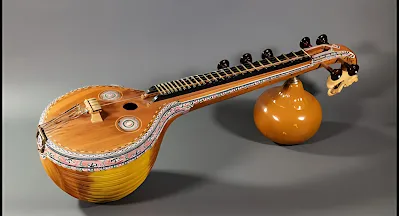Carnatic Music (243)
Tutor Marked Assignment
20% Marks Of Theory
1. Answer any one of the following questions in about 40-60 words.
(a) Specify the element that beautifies the Svara phrases and the Raga of Indian music.
Answer: The element that beautifies the Svara phrases and the Raga of Indian music is the melody. The melody, created by the arrangement and sequence of Svaras, is the soul of Indian classical music. It gives the Raga its unique identity and evokes emotions in the listener.
2. Answer any one of the following questions in about 40-60 words.
(a) Why it is said that Raga is easy for the beginners to learn? Specify.
Answer: Raga is said to be easy for beginners to learn because it follows a set of rules and patterns. These rules, known as "vadi" and "samvadi," dictate the relationship between the notes in a raga. By understanding these rules, beginners can easily grasp the structure of a raga and learn to play it. Additionally, ragas often have a distinct mood or emotion associated with them, making it easier for beginners to connect with the music on a personal level.
3. Answer any one of the following questions in about 40-60 words.
(a) Explain any two instruments in which the strings are made to vibrate and produce sound.
Answer: Two instruments where strings are made to vibrate and produce sound are:
1. Guitar: A popular stringed instrument with six strings, usually made of nylon or steel. The player plucks or strums the strings to create vibrations that produce sound.
2. Violin: A classical stringed instrument with four strings, typically made of gut or synthetic material. The player uses a bow to draw across the strings, causing them to vibrate and produce sound.
4. Answer any one of the following questions in about 100-150 words.
(a) ‘Harmonium and Clarinet did not become so popular in India’. Give any four reasons.
Answer: Four reasons why harmonium and clarinet did not become as popular in India as other instruments:
1. Cultural Preference: India has a rich tradition of indigenous instruments like the sitar, tabla, and mridangam. These instruments have deep cultural roots and are often preferred for classical music.
2. Musical Aesthetics: The sound of the harmonium and clarinet, while versatile, may not perfectly align with the specific musical aesthetics and traditions of Indian classical music.
3. Technical Limitations: The harmonium, being a reed instrument, is susceptible to tuning issues and may not always produce the desired range of sounds. The clarinet, while expressive, may not be as well-suited for certain Indian classical ragas.
4. Historical Context: The introduction of the harmonium and clarinet to India was relatively recent, and they may have faced resistance from traditional musicians who were accustomed to using indigenous instruments.
5. Answer any one of the following questions in about 100-150 words.
(b) Relate a string instrument with a wind instrument used in Carnatic music and write in detail.
Answer: Two prominent instruments in Carnatic Music, one a string instrument and the other a wind instrument, are the veena and the flute.
The Veena: This is a fretted, plucked string instrument known for its rich, resonant sound. It has a long neck and a gourd-shaped body, and is often adorned with intricate carvings and inlays. The veena is played by plucking the strings with one hand while pressing the frets with the other, allowing for a wide range of melodic expressions.
The Flute: Also known as the "venu," the Carnatic flute is a transverse flute made of bamboo. It is played by blowing air into the mouthpiece and using fingers to cover the holes, producing a sweet and melodious sound. The flute is often used as a solo instrument or as an accompaniment to other instruments in Carnatic ensembles.
Both the veena and the flute are versatile instruments that can be used to express a wide range of emotions and musical ideas in Carnatic music. They complement each other beautifully, creating a harmonious and captivating musical experience.
6. Prepare any one project of the following projects given below.
(a) Collect three photographs of Wind instruments and paste them into your project file. Now write in brief about each of these instruments.
Answer: There are three photographs of wind instruments, brief descriptions:
1. Flute: The flute is a woodwind instrument known for its sweet, melodious sound. It is typically made of wood or metal and played by blowing air into a mouthpiece and covering the holes with fingers. The flute is a versatile instrument that can be used in a variety of musical genres, from classical to jazz to pop.
2. Clarinet: The clarinet is a woodwind instrument with a single reed mouthpiece. It has a distinctive, mellow sound and is often used in classical, jazz, and popular music. The clarinet is played by blowing air into the mouthpiece and covering the holes with fingers. It is known for its expressive range and ability to play both melodic and harmonic lines.
3. Saxophone: The saxophone is a woodwind instrument with a curved body and a single reed mouthpiece. It is played by blowing air into the mouthpiece and covering the holes with fingers. The saxophone is known for its rich, powerful sound and is widely used in jazz, blues, and rock music. There are several different types of saxophones, each with a slightly different sound and range, including the soprano, alto, tenor, and baritone saxophones.

%20EM%20Solved%20TMA%202024-25.webp)




